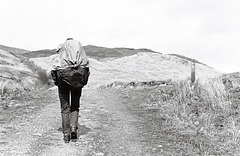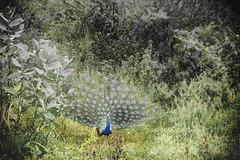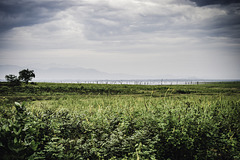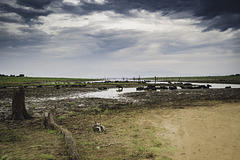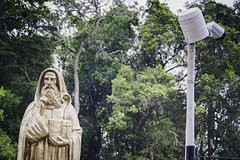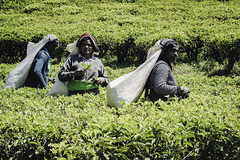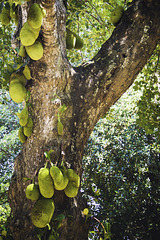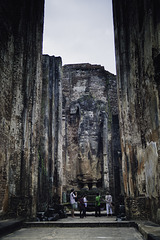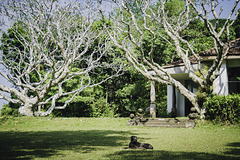m̌ ḫ's photos
Starting the trek
| |
|
|
|
We did 4 day hiking of this eponymous trek in Scottish Highlands in April 2013. It was a fantastic experience. Despite the relatively low altitude as well as forestation, the Highlands can offer many unique sides - its vast valleys, and a very Northern feeling of these majestic old mountains. Also the colours are astonishing, the contrast between a picturesque sky of all shadows of blue, grey, yellow or black... with the natural tones of the greenery, flowers, rocks, soil... A weather issue must be mentioned also. The april weather was quite cold, with rain and wind, but we saw sun every day, even if it was for a 15 minutes (after whole day of rain, one enjoys this moment like never before). Plus we got soon into appreciation of the Scotch whisky. And an important positive was that in this time of the year, there aren't any infamous little flies known as midges . It's recomended as a gateway trek in Scotland, and it's worth it... Truly, a strong side of Scotland lies in the countryside. What better place to experience it than in the mountains.
...
Some facts ( www.walkhighlands.co.uk )
The West Highland Way was Scotland's first long distance route and remains by far the most popular. Stretching for 151km from Milngavie on the edge of Glasgow to Fort William at the foot of Ben Nevis, the route offers a fabulous introduction to the Scottish Highlands. Those wanting to add an extra days walking could even begin in the heart of Glasgow, reaching Milngavie by following the Kelvin Walkway.
It offers tremendous variety, beginning in the pastoral landscapes beneath the Campsies, past the serene beauty of Loch Lomond, and on into increasingly rugged and majestic Highlands. It then crosses the vast, awe-inspiring expanse of Rannoch Moor, with a glimpse down Glencoe, before crossing the hills to lovely Loch Leven. The route finally reaches Fort William via beautiful Glen Nevis. The very keenest could continue from the town by walking the Great Glen Way, or the unofficial East Highland Way.
Looks like Himalaya
| |
|
|
|
The Highlands lie to the north and west of the Highland Boundary Fault, which runs from Arran to Stonehaven. This part of Scotland is largely composed of ancient rocks from the Cambrian and Precambrian periods which were uplifted during the later Caledonian Orogeny. Smaller formations of Lewisian gneiss in the northwest are up to 3 billion years old. The overlying rocks of the Torridon Sandstone form mountains in the Torridon Hills such as Liathach and Beinn Eighe in Wester Ross.
These foundations are interspersed with many igneous intrusions of a more recent age, the remnants of which have formed mountain massifs such as the Cairngorms and the Cuillin of Skye. A significant exception to the above are the fossil-bearing beds of Old Red Sandstone found principally along the Moray Firth coast and partially down the Highland Boundary Fault. The Jurassic beds found in isolated locations on Skye and Applecross reflect the complex underlying geology. They are the original source of much North Sea oil. The Great Glen is formed along a transform fault which divides the Grampian Mountains to the southeast from the Northwest Highlands.
The entire region was covered by ice sheets during the Pleistocene ice ages, save perhaps for a few nunataks. The complex geomorphology includes incised valleys and lochs carved by the action of mountain streams and ice, and a topography of irregularly distributed mountains whose summits have similar heights above sea-level, but whose bases depend upon the amount of denudation to which the plateau has been subjected in various places.
Shapes of a Scottish midday
| |
|
|
|
Highlands
| |
|
|
|
Four hours in London
| |
|
|
|
Gents or chavs?
| |
|
|
|
Peacock in action
| |
|
|
|
Land of the elephants
| |
|
|
|
Sky, water and buffalo
| |
|
|
|
Saint and the camera
| |
|
|
Tea shrubs in beautiful nature of Sri Lankan mount…
| |
|
|
|
Probably the best-known of Sri Lanka’s tea-growing districts, Nuwara Eliya is also the most rugged and mountainous, with the highest average elevation. The air is cool and bracing; the winds are scented with eucalyptus and wild mint. Rainfall is moderate except during the dry season, which falls between February and April. Nights are cold and sometimes frosty. This unique climate, combined with the terrain peculiar to the region, produces a tea that is recognized by connoisseurs as among the finest – if not the finest – in the world.
Historically speaking, Nuwara Eliya is a relatively new place. The town from which the district takes its name sits perched on a plateau 1,868 m above sea level, under the shadow of Sri Lanka’s highest mountain, Pidurutalagala. Almost inaccessible in olden times due to the precipitous, jungle-clad terrain surrounding it, this scenic plateau was effectively uninhabited when it was discovered by an English explorer in 1818. Impressed by its magnificent scenery and climate, Sir Edward Barnes, the British governor of the time, resolved to turn the locale into the similar of Ceylon, a fashionable hill-station to which the government and society of the capital, Colombo, could repair during the hottest and unhealthiest months of the year. He accomplished this by the simple expedient of building a house there himself, and occupying it every year between March and April. ‘Newralia’ thus became, for a few weeks every year, the capital of colonial Ceylon.
www.pureceylontea.com/index.php/nuwara-eliya
Tamil tea pickers
| |
|
|
|
Tamil tea pickers in Sri Lanka, most of whom are descendants of indentured laborers brought from southern India by British colonizers, play a crucial role in the country's tea industry, which is a significant part of its cultural heritage and economy. The tea industry in Sri Lanka, known for producing Ceylon tea, began in the 19th century when large amounts of labor were needed for the tea plantations. Even today, tea leaves in Sri Lanka are plucked by hand to ensure that only the tender leaves are selected, a labor-intensive task that has been historically undertaken by the Tamil workforce.
The cultural significance of Tamil tea pickers is deeply intertwined with the history of Ceylon tea itself. The tea industry was established during British colonial rule, and the Tamil workers have been a backbone of this industry since its inception. The tea they pick is renowned worldwide for its quality and contributes significantly to Sri Lanka's economy. In 2022, the industry generated £1.079 billion in exports despite facing a 26-year low in production due to an economic crisis.
However, the Tamil tea pickers have faced numerous challenges, including poverty, poor living conditions, and a lack of alternative employment opportunities. Many still live in the tiny homes built by the British, with some lacking basic amenities like running water or toilets[1]. Despite the global reputation of Ceylon tea and the wealth it generates, the Tamil tea pickers remain among the most disadvantaged segments of Sri Lankan society.
The tea industry's reliance on Tamil labor and the unique hand-plucking method contribute to the cultural significance of Ceylon tea. The Tamil tea pickers' contribution is not only economic but also a preservation of a traditional way of life that has been passed down through generations, despite the hardships they endure.
Jackfruit tree
| |
|
|
The jackfruit (Artocarpus heterophyllus), also known as jack tree, fenne, jakfruit, or sometimes simply jack or jak, is a species of tree in the fig, mulberry, and breadfruit family (Moraceae) native to South India. The jackfruit tree is well suited to tropical lowlands, and its fruit is the largest tree-borne fruit, reaching as much as 35 kg in weight. A mature jackfruit tree can produce about 100 to 200 fruits in a year. The jackfruit is a multiple fruit, composed of hundreds to thousands of individual flowers, and it is the fleshy petals that are eaten. The jackfruit tree is a widely cultivated and popular food item throughout the tropical regions of the world.
A bigger friend
| |
|
|
Royal Botanic Gardens, Peradeniya are about 5.5 km to the west of the city of Kandy in the Central Province of Sri Lanka. Their origins date as far back as 1371 when King Wickramabahu III ascended the throne and kept court at Peradeniya near the Mahaweli river. This was followed by King Kirti Sri and King Rajadhi Rajasinghe. A temple was built on this location by King Wimala Dharma, but it was destroyed by the British when they were given control over the Kingdom of Kandy. Thereafter, the groundwork for a botanical garden was formed by Alexandar Moon in 1821. He used the garden for coffee and cinnamon plants.
The Botanical Garden at Peradeniya was formally established in 1843 with plants brought from Kew Garden, Slave Island, Colombo, and the Kalutara Garden in Kalutara. Today it is managed by the Division of National Botanic Gardens of the Department of Agriculture.
en.wikipedia.org/wiki/Royal_Botanical_Gardens,_Peradeniya
Headlong
| |
|
|
|
Our great friend
| |
|
|
|
Heritage of the wise men and women
| |
|
|
Sandakada pahana, also known as Moon-stone , is a unique feature of the Sinhalese architecture of ancient Sri Lanka. It is an elaborately carved semi-circular stone slab, usually placed at the bottom of staircases and entrances. First seen in the latter stage of the Anuradhapura period, the sandakada pahana evolved through the Polonnaruwa, Gampola and Kandy period. According to historians, the sandakada pahana symbolises the cycle of Saṃsāra in Buddhism.
Sunny afternoon
| |
|
|
Geoffrey Manning Bawa (23 July 1919 – 27 May 2003) was a Sri Lankan architect. He is the most renowned architect in Sri Lanka and was among the most influential Asian architects of his generation. He is the principal force behind what is today known globally as "Tropical Modernism".
He was born half British, and being orphaned at a very early age. He got his Law degree from London and came back to Sri Lanka to work as a lawyer, following the Bawa family tradition. He soon grew weary of being a lawyer and went on a vacation to Italy where he was utterly captivated by the Italian gardens and had to resist buying an Italian lake house. This is where tropical, Mediterranean architecture and landscaping got stuck in his head. He came back to Sri Lanka and bought a rubber plantation in the Bentota area in 1948, to make his own garden home. However, finding that he lacked in skills and technicalities, he left for London to study as an architect. In 1957, he was a qualified architect and back home. He began planning and designing his Lunuganga country home. He took serious inspiration from Italian renaissance gardens and gave it a subtle modern twist.
Geoffrey and his brother Bevis were part of a milieu of sophisticated homosexuals who were drawn to the idea of Ceylon as a place of beauty, sensuality and escape. Bawa's architecture is at one with the land: inside and outside blend seamlessly, and it is designed for the maximum pleasure of its inhabitants. He was influenced by colonial and traditional Ceylonese architecture, and the role of water in it, but rejected both the idea of regionalism and the imposition of preconceived forms onto a site.
Bawa became an Associate of the Sri Lanka Institute of Architects in 1960. An ensuing close association with a coterie of like-minded artists and designers, including Ena de Silva, Barbara Sansoni and Laki Senanayake, produced a new awareness of indigenous materials and crafts, leading to a post-colonial renaissance of culture.

